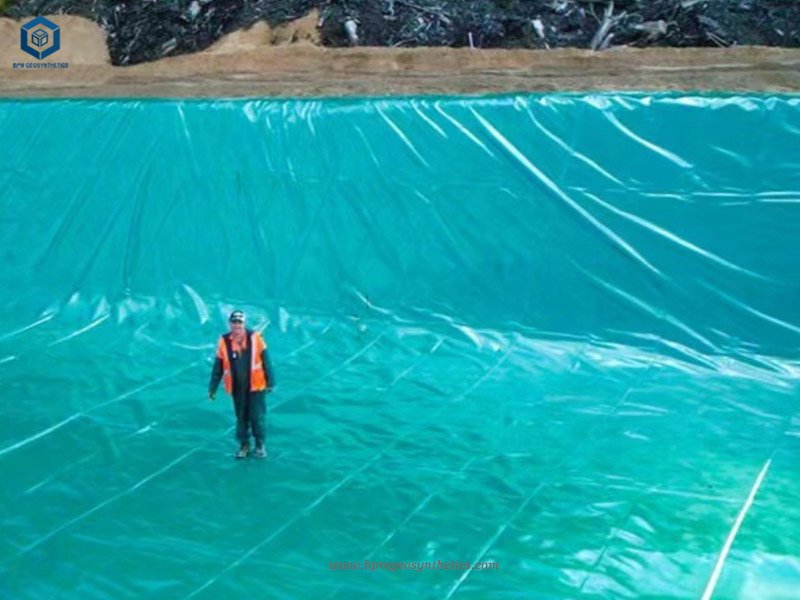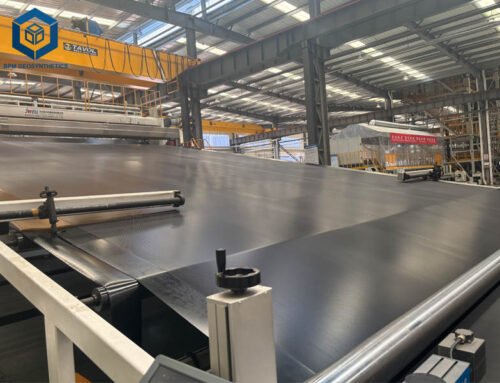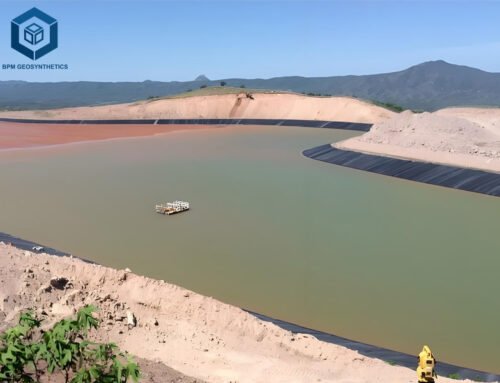Geomembrane cost can vary based on several factors including the material type, thickness, size, application, colors and any additional features or customization. Generally, geomembrane is manufactured with different colors such as black, white, blue or green for specific applications. Black geomembrane is the common geomembrane liner. Colored geomembrane is designed for specific projects. The colored geomembrane cost is higher than black geomembrane.
BPM Geosynthetics is the professional geomembrane manufacturer and supplier, we wholesale a complete line of geomembranes for a variety of civil engineering applications. When selecting geomembrane, you should balance the quality and geomembrane cost. Why colored geomembrane cost is higher than black geomembrane? Why colored geomembrane cost is higher than black geomembrane? In this article, let’s take HDPE geomembrane with the same thickness and size to explain the geomembrane cost. We hope this article will help you to choose the right colored geomembrane with reasonable cost for specific projects.
1. What Is A Geomembrane
1.1 Definition and Composition of Geomembranes
Geomembranes are synthetic, impermeable barriers designed to control fluid and gas movement in engineering projects. Manufactured from durable polymers like HDPE, PVC, PP, and EPDM, these liners are produced in sheets with thicknesses ranging from 0.5 to 3.0 mm. Their primary function is to create reliable containment when paired with soil or rock structures.
1.2 Key Applications and Environmental Protection
These membranes serve as essential protective barriers across industries. Common uses include landfill liners, mining operations, water storage reservoirs, and wastewater treatment facilities. By preventing hazardous leaks and seepage, geomembranes safeguard ecosystems while maintaining structural integrity in man-made systems.
1.3 Varieties and Specialized Designs
Geomembranes are available in multiple configurations to meet project needs. Smooth-surface liners offer basic containment, while textured HDPE variants provide enhanced grip for sloped installations. Composite geomembranes combine materials to deliver tailored properties like chemical resistance or reinforced durability for challenging environments.
1.4 Performance and Engineering Significance
As critical components in containment systems, geomembranes ensure long-term stability by blocking fluid migration. Their adaptability to different terrains and resistance to environmental stressors make them indispensable for infrastructure projects prioritizing safety and sustainability. Proper selection and installation contribute significantly to project success and environmental compliance.
2. What are HDPE Geomembrane Color Options?
2.1 Color Options and Availability
Geomembranes are available in multiple colors, including black, gray, green, and blue, though options vary by manufacturer. Customers should verify available colors with suppliers, as not all hues may be offered for every product type. BPM Geosynthetics provides customizable color solutions to align with project specifications and aesthetic goals.
2.2 Manufacturing Process of Colored Geomembranes
Colored geomembranes are produced by incorporating specialized color masterbatches during manufacturing. These pigment-rich additives are precisely measured to ensure uniform color distribution and consistent intensity across the liner. The process maintains the geomembrane’s structural integrity while meeting visual or functional requirements, such as UV resistance or environmental blending.
2.3 Functional and Aesthetic Applications
Color selection serves both practical and visual purposes. Black liners reduce light penetration in landfills, while green or gray options blend with natural landscapes. Blue geomembranes are popular for water containment due to their aesthetic appeal. BPM tailors colors to project needs, ensuring optimal performance and design harmony.


3. Why Is Geomembrane Colored?
Geomembranes are available in various colors to cater to different project requirements and customer preferences. Colored geomembranes offer several benefits:
3.1 Enhanced Protection
Colored geomembranes can provide additional protection to the material. For instance, certain colors can offer UV protection, helping to shield the geomembrane from the harmful effects of sunlight. This protection can contribute to extending the service life of the geomembrane and maintaining its mechanical properties.
3.2 Aesthetics
Colored geomembranes can enhance the overall aesthetics of a project. By choosing a specific color that complements the surrounding environment or matches the desired visual theme, the geomembrane can seamlessly integrate into the project and provide a more pleasing appearance.
3.3 Differentiation and Identification
Using colored geomembranes can aid in differentiating specific areas or sections within a project. By assigning different colors to different zones, it becomes easier to identify and delineate various functional areas, such as distinct containment zones or specific operational areas.
3.4 Visual Safety
Certain colors can be used to enhance safety measures. For instance, brightly colored geomembranes can help increase visibility in hazardous areas or mark out important zones, ensuring better safety awareness and adherence to designated areas.
By offering geomembranes in a variety of colors, such as black, gray, green, blue, and others, geomembrane can meet diverse project requirements and customer needs. This range of colors allows for customization, ensuring that the geomembrane not only fulfills its functional role but also contributes to the overall aesthetics and performance of the project.
4. Why Is Colored Geomembrane Cost Higher Than Black Beomembrane?
In the same thickness, same size, the factors that affect the price of geomembrane mainly include the following aspects:
4.1 Raw Material Costs
The coloration process involves adding pigments or dyes to the geomembrane material. These additives can increase the overall cost of production compared to the base black geomembrane, which doesn’t require additional colorants.
4.2 Pigments and Dyes
The pigments and dyes used to achieve color in geomembranes often come with their own costs. High-quality, durable, and UV-resistant pigments may be more expensive, contributing to the overall cost of the colored geomembrane.
4.3 UV Stability Requirements
Colored geomembranes, especially those used in outdoor applications, may require additional UV stabilizers to prevent color fading and maintain their appearance over time. These UV stabilizers can add to the cost.
4.4 Manufacturing Process
The manufacturing process for colored geomembranes is more complex than that for black geomembranes. The addition of colorants requires precise blending and quality control measures, leading to increased production costs.
4.5 Specialized Applications
Colored geomembranes are often used in specific applications where aesthetic considerations or color-coding for different functions are essential. The niche nature of these applications might result in lower production volumes, contributing to higher unit costs.
4.6 Technical Specifications
Colored geomembranes may need to meet specific technical specifications, such as color consistency, which can require additional quality control measures during manufacturing.
4.7 Customization and Order Size
Colored geomembranes are often produced in smaller quantities and may involve customization based on the specific requirements of the project. Customization and smaller order sizes can contribute to higher costs.


5. Conclution
It is worth considering that colored geomembranes, despite being potentially more costly, provide advantages in terms of aesthetics, visibility, and distinction in specific applications. The decision between colored and black geomembranes relies on various project requirements, encompassing functional and aesthetic factors, as well as budgetary limitations.
As a leading manufacturer, BPM Geosynthetics has mature production process of colored geomembrane.Welcome send inquiry to us.





